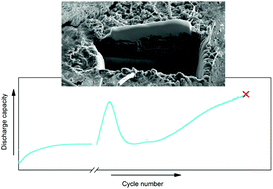Mechanistic insights into the phenomena of increasing capacity with cycle number: using pulsed-laser deposited MoO2 thin film electrodes†
Abstract
Lithium ion batteries typically lose capacity or energy storage density (i.e. capacity fading) over the course of extended cycling which can be problematic for applications and appears to be exaggerated when high current rates are used. However, in some cases fluctuations in capacity with cycle number and even increases in capacity with cycle number are noted with predominantly thin film based electrodes. Here we demonstrate the synthesis and in-depth characterisation of laser deposited MoO2 thin film anodes and its unconventional mechanism. A MoO2 electrode shows an initial capacity of 79 mA h g−1 which increases to capacities of 600 mA h g−1 at 15.8 A g−1 after 90 000 cycles. A maximum capacity of 1714 mA h g−1 was achieved in an electrode cycled at 1.5 A g−1 for over 3800 cycles, the highest recorded capacity in MoOx anodes to date. The most intriguing aspects of this work is the fact that capacity is shown to fluctuate and typically increase well above the theoretical capacity of MoO2. A combination of electrochemical cycling, X-ray diffraction, X-ray photoelectron spectroscopy, scanning electron microscopy, energy dispersive spectroscopy, focused ion beam milling and transmission electron microscopy at various states of cycling is used to illustrate a proposed mechanism. The mechanism illustrated is based on exfoliation of layers of MoO2 off the pulsed laser deposition (PLD) grown MoO2 electrodes during cycling that creates additional surface area and easier access for Li-ions to both adsorb to the surface and insert/react with the host material. Further features in the capacity evolution are rationalised by this mechanism and methods to control the capacity evolution are detailed. These results present a rational explanation for when an electrode undergoes a substantial increase in capacity over its extended cycling life.



 Please wait while we load your content...
Please wait while we load your content...